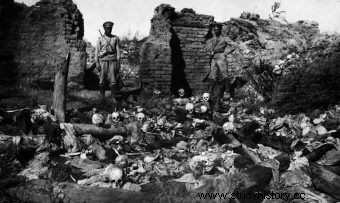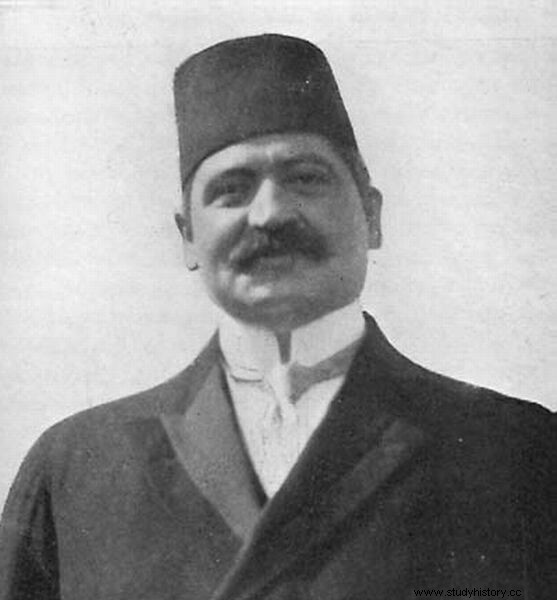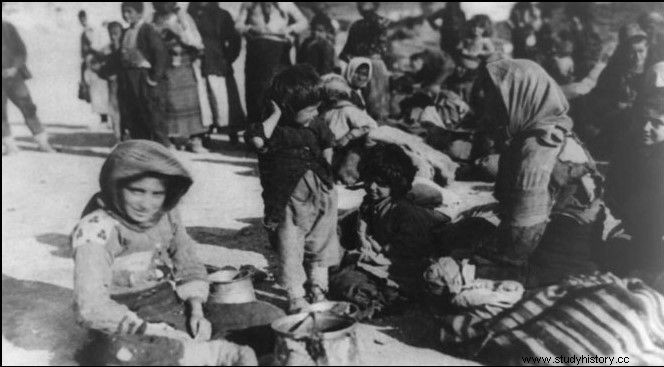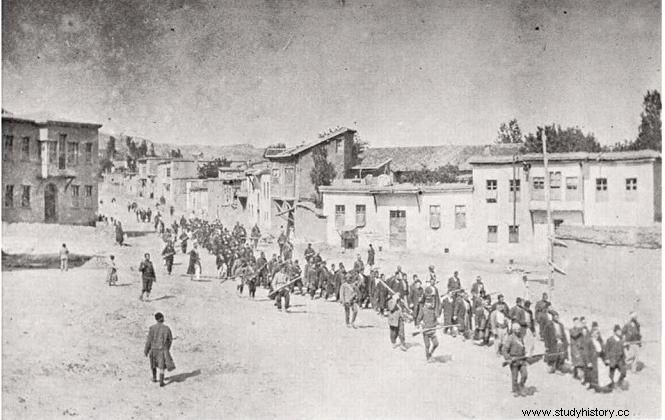On August 22, 1939, Adolf Hitler, a week before the attack on Poland, was reportedly supposed to deliver the famous "Armenian quote", saying to the Wehrmacht leaders:Kill women, old men and children without mercy; what matters is speed and cruelty. Who remembers the Armenian massacre today?
There hasn't been much to the truth. 24 years earlier, an unimaginable crime took place in the Ottoman Empire, which the Turkish authorities committed against the Armenian population. These events almost led to the extermination of the descendants of the oldest Christian state.
Who were the Armenians?
The Armenians call their homeland Hajastan, although we know it under the name of Armenia. Historically, the country occupied the highlands between the Caucasus, Asia Minor, and Persia. Always located on the border between Europe and Asia in 301, this country established Christianity as its religion, thus becoming the first Christianized country.

The Armenian slaughter is the first modern genocide
However, with the territorial changes in Anatolia, the Armenian country was finally absorbed by the Ottoman Empire which at its peak stretched from the Caspian Sea to almost Vienna. Life within its borders was relatively easy for national minorities, as long as they agreed to operate according to the rules imposed by the sultan and to pay the taxes imposed on them regularly.
This heterogeneous country has developed a number of laws designed to ensure the safe coexistence of citizens of different nationalities inhabiting its borders. And although it worked quite well at first, the advent of the 19th century changed everything. It was then that the national identity began to develop strongly, and with it emerged separatist thoughts, also among the Armenians. These moods did not like the Empire's rule, which led to the first pogroms of the Armenian population, carried out on the orders of Sultan Abdulhamid II.

French caricature of Sultan Abdülhamid II as a butcher
These events took place in the years 1894-1896 and it is estimated that about 300,000 people died during them. Armenian. And it was a harbinger of a tragedy yet to come.
Young Turks
In 1908, a new political movement - the Young Turks - comes to power in the Ottoman Empire. They carried out a military coup, forcing the autocratic Sultan Abdulhamid II to resign.
This grouping was referred to as an umbrella organization with a better vision of the country than the sultan. They believed that the state could not develop without a constitution and a parliament. They were also meant to herald a new era that heralded a change in attitudes towards the unbelievers. This was reflected, for example, by the consent for Armenians to join the military ranks. However, the joy of these changes did not last long.
In 1912 and 1913, as a result of two Balkan wars, the Ottoman Empire lost its lands on the Balkan Peninsula, which accounted for over 70% of its European territory. It was a serious blow, which was additionally aggravated by the waves of Turkish refugees flowing in from these areas.

Mehmet Talat Pasha
In Istanbul, over 100,000 people appeared in a very short time. war emigrants. They were crowds of bitter people whose fortunes were lost and hungry in the streets of the city because the government was unable to help them. Their stories of what had befallen them with Christians strengthened nationalist sentiments and internal tensions, focusing on the infidels remaining in the Ottoman Empire.
The loss in the Balkans and the fear of further uprisings became the main driving force of Turkish nationalism. The Turkish nation was afraid of losing Anatolia, and with it the belief that all methods of defending it were justified.
Influenced by these events, in 1913 a radical nationalist squad of young adults gained full control of the government . It was headed by Mehmet Talaat, who together with the Minister of Defense, Ismail Enver, and Ahmed Cemal, the minister of the navy, formed the "Young Turkish triumvirate". Turkish nationalism was at the heart of their ideology, and the main goal was to create a homeland for the Turks in Anatolia. The slogan behind their actions was:"Turkey for the Turks".
Enemy within
After the outbreak of World War I, the Ottoman Empire sided with Germany. Enver counted on the use of German influence in expanding the country's borders to the east. He planned to conquer the Caucasus and the Russian part of central Asia, thus uniting the Turks living there. It was the next stage in the creation of the great Turkish state.
Unfortunately, the Turks suffered a defeat in the first clashes with Russia, and the most painful one was in January 1915 at Sarikamis. And it was this defeat that the Ottomans wrongly blamed the Armenians for.

Armenian refugees from the Ottoman Empire in 1915
There were many Armenian soldiers in the Russian ranks. They came from tsarist lands, but there were also Turkish refugees among them. And it was their presence in the enemy army that infuriated the Ottoman commanders.
Fearing a greater number of Armenians joining the enemy, the "Young Turkish triumvirate" considered the Armenian nation, located within the state borders, a threat. The decision was made to disarm all Armenians in the ranks of the Turkish army and gather them into working battalions whose tasks included, inter alia, building roads or cleaning latrines, and they were murdered after the work was done.
The elimination of young, strong men was the first stage of the Armenian genocide.
Death marches
On April 24, 1915, an order was issued to arrest the Armenian intelligentsia and spiritual leaders. They were isolated from the rest of the community and placed in prisons in the interior of the country where they were tortured and murdered . In total, practically the entire generation of Armenian intellectuals was killed. This strategic move confused the population, making it more vulnerable to efforts to exterminate it.
Another aspect was the urgent legal acts that allowed the arrests and deportations of Armenians from all areas of the Empire. These actions led to the displacement of entire villages and towns. People were told that they would be relocated to unknown settlements in the interior of the country. In fact, the police, accompanied by soldiers, were rushing columns of defenseless Armenians towards the Del-el-Dzor desert in what is now Syria.
These death marches were planned in such a way that as many people as possible died . The heat, lack of water, lack of rest and regular attacks by special forces (made up of ex-criminals) as well as Kurds and incited local communities led to the death of hundreds of thousands of Armenians.
The routes of the march led along the longest routes through the mountains. Without stops, food, water, and medical care, people died one by one. The weakest - the sick, the oldest, pregnant women and children - left first. People who could not keep up with the column were killed on the spot. The death march tracks marked the bodies left on the roadside. With each passing day, the caravans grew smaller.

In the years 1915–1917, approximately 1.5 million Armenians were murdered in Turkey
There is evidence that so many bodies were thrown into the Euphrates that the river water turned red with blood. People who could not stand the pain and suffering decided to jump and drown themselves, just to end this nightmare march.
Some of the Armenians were transported to Del-el-Dzor by rail in freight cars. For many of them the journey itself turned out to be fatal. Huddled like cattle for slaughter, they were dying of thirst and lack of air. The scary fact was that the Armenian people had to pay for the ticket themselves, which was supposed to be a cover for the Turkish government and its activities.
The bestiality of the Turks towards the Armenians is astonishing - it seems that the torturers were deliberately leading them to a state of a kind of dehumanization. Thrown out of their homes, led nowhere through the desert, and on the way robbed and cruelly killed, they eventually went mad with hunger and thirst - they ceased to show ordinary human reactions. It is hard to imagine the suffering they were subjected to. Certainly, it will not help much to cite just some of the documented cases, such as shoeing people who were dealt with by Dżewded Pasha, known as the "Bakchala blacksmith" or sinking rafts with people in the Tiger. Setting on fire, mutilation, gang rape are common practices of the Turks against the Armenian people .
The few who reached the desert settled in makeshift concentration camps. Many of them starved to death or were murdered. It is estimated that over 1,000,000 Armenians died during the entire pogrom. The events of 1915–1916 were watched by many foreign journalists, missionaries, diplomats, and military officers who sent home reports of the marches and the fields of death. The largest archive of around 4,000 eyewitness testimonies to these events is currently in the US.
The process of displacement
Despite the fact that after World War I, sentences were handed down to convict those guilty of this crime, the Turkish state has refused to call those events a genocide to this day. However, in the light of this policy, it is worth remembering that the creator of the term "genocide", Rafał Lemkin, cited the tragedy of the Armenians as one of the key examples of this type of crimes against humanity.
